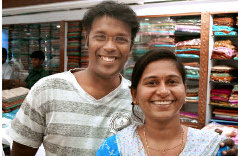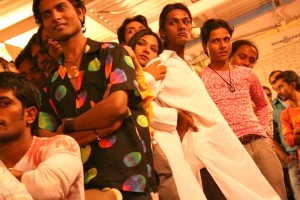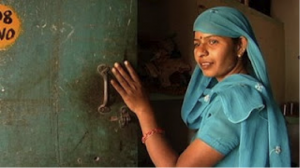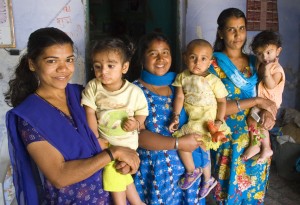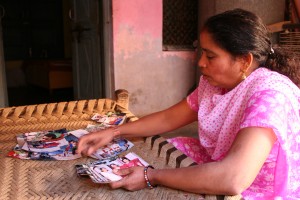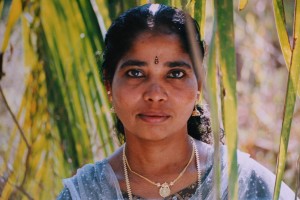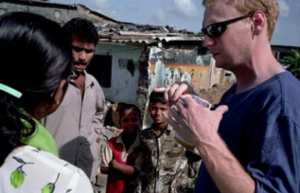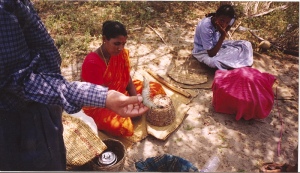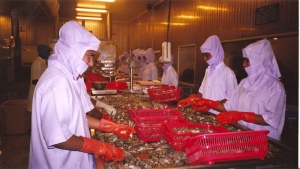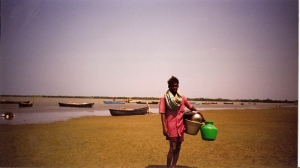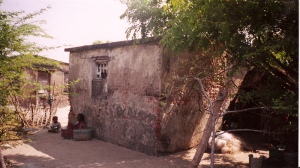By Wu Nan (class of 2008)
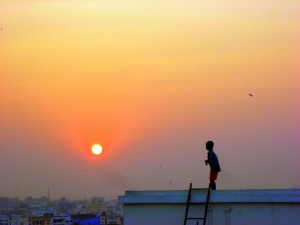 AYODHYA, Uttar Pradesh, December 2007—This is the way pilgrims reach Ayodhya. Thirty minutes before the Farakka Express left for Delhi, passengers filled track Number 11. As they waited to board, some kept warm with wraps, others with blankets or rugs. Young girls and children fell asleep on the ground as rats scurried to get the crumbs under nearby benches.
AYODHYA, Uttar Pradesh, December 2007—This is the way pilgrims reach Ayodhya. Thirty minutes before the Farakka Express left for Delhi, passengers filled track Number 11. As they waited to board, some kept warm with wraps, others with blankets or rugs. Young girls and children fell asleep on the ground as rats scurried to get the crumbs under nearby benches.
Ayodhya, the site of a 1992 religious riot between Hindus and Muslims, first caught my interest this past December when the government announced another delay—the 43rd—in issuing its investigation of the incident. Again, the Muslim and Hindu activists blasted the government and the sharpness of their argument made me wonder about the the depth of such religious and political.
The facts are these: Up until December 6, 1992, Ayodhya, a city of less than 50,000 population and over 460 miles east of Delhi, was the site of the 16th Century Babri Mosque. Hindus had long argued that it was also the birthplace of Ram, their most important deity, but India’s first prime minister put an end to the dispute in 1949 when he closed the mosque. That settled the issue until the 1986 when a district judge reopened it and a new party, known as the BJP, began to use the issue of the mosque as a way to cut across class lines and attract Hindu voters. Hindus compose 80 percent of the country, compared to the 13 percent that identifies as Muslim.
On that December morning in 1992, the BJP gathered 600,000 Hindus near the mosque to call for building a Hindu Temple. A dozen Hindu activists broke through the police barrier around the mosque and others soon followed. Within hours, the mosque was destroyed. The wave of violence that followed ended with 2,000 deaths and the appointment of the Liberhan Commission.
The original mission for the Liberhan Commission was within two months to report on who are responsible for the destruction and how and why it happeneds. Fifteen years later the unpublished report still sits on Judge Liberhan’s desk. I wondered how the report failed to come out and a centuries old religious feud could arouse such passions. I went to India to try and to understand Ayodhya and its aftermath.
There I was at the station, anxiously expecting my destination, Ayodhya. Each year the town attracts over 500,000 pilgrims, ten times larger than its population. Why? Thinking about it, I saw a faded blue train approached the platform. As the train pulled in, the crowd rose and chased it. Passengers jumped into the dark carriages looking as if they had been swallowed by a magician’s box. I held my train ticket but had no idea what carriage was mine.
The crowds suddenly pushed me into the carriage in front of where I stood. It was dark inside. Minor light came through tiny windows with iron bars. Others scrambled through touching each seat and reading the numbers. I knew I had a sleeper, but had no idea where it was. I tried to get out but too many passengers were pushing in. As I looked through the bars, I thought we must look like animals trapped in a cage.
I finally squeezed out and found help from one staff in red-cap. He led me to a board stuck with a forest of papers filled with hundreds of names. Miraculously, he found mine.
Inside my car, white bulbs dangled above each cabin; the rectangular block with six bunks on either side that were separated by a narrow aisle. Dark blue curtains covered every bed and cut the whole space into smaller parts. The air was stuffy; a child cried from behind one of the curtains.
This was completely opposite experience when I took a train days ago to Chandigarh I thought. The first class air conditioned I boarded had coffin seats, food and drinks served during the entire journey.
I went there to visit Anupa Gupta, the commission’s counsel and only lawyer. He lives in that city planned by the French architect Le Corbusier in 1950’s. Four hours south of Delhi, it’s known for its civilization of the western layout of wide, tree-shaded avenues where traffic runs in an orderly fashion.
Gupta, a lawyer in his early 40s, met me at the gate of his two story house. He is of medium height, slim and was dressed in a gray suit, white shirt and a traditional British, 18th century style tie. He smiled, looking like a character in a movie as he welcomed me into white stone house. We walked through the small garden in front and up to the second floor office. There, the walls were lined with books including a collection on the American Constitution.
“Ayodhya is an extremely dangerous issue,” Gupta said.
How, asked Gupta, could the passions of an old argument incite a million people?
Interested the issue, Gupta joined the commission in 1999 when Judge Liberhan had struggled early on and ended up firing his lawyers at that time. Immediately, the pace picked up and by 2001, Gupta began interviewing L.K. Advani, the head of the BJP party, which came into power by trumpeting Hinduism—a religion practiced by 80 percent of the country compared with the 13 percent who practice Islam
Advani is considered core to what happened to the Babri Mosque because he was the prime minister at the time of the incident. When Gupta’s questioning offended Advani, he heard from Judge Liberhan who asked him to tone down his questions to the the former prime minister.
“I said I’d rather quit the commission,”said Gupta. “After this he (Advani) was very wary of me.”
Gupta wrote 200 pages on his deposition of Advani. In the following nine years he also heard the testimony of nearly a hundred witnesses. His understanding of the Ayodhya issue, he said, got deeper and sharper. The last witness to testify was Kalyan Singh, the chief minister of Uttar Pradesh (UP), the state where Ayodhya is located. After Singh’s testimony, Gupta filed a 400 page report defining Singh’s role in Ayodhya incident. He said these reports are important evidence for what happened in Ayodhya.
“The complete truth has to be told,” he said.
When asked why the report has been delayed so many times, however, Gupta and says simply that it’s incomplete and mentions his lack of a computer and a staff of only 20.
“Was this really how such an important report stuck? And the passion still drives the pilgrims to travel on a tough trip I am enduring?” I asked myself. The train was running fast. And the next minute I fell asleep in the darkness.
I finally arrived 14 hours later. Unexpected, my interpreter took me to the Faizabad district police station where the police head wanted me to register as a foreign reporter. I was told Ayodhya is highly sensitive place and I would be accompanied by a police guard to make sure I’m in a safe area. I noticed even the women police there were armed.
My guard in green uniform nodded me and sat silently at the front of a van my interpreter booked. I sat in the back with my interpreter. We slowly drove on the stone paved road. The van trembed and made noises, while other cars, bikes, people and donkeys passed us.
This is Ayodhya, typical of those cities built by India’s Muslim rulers in the 15th century. Low-slung houses and shops filled the narrow streets. The only thing that makes it unique is that every five to 10 meters there’s a uniformed police officer, similar to my guard. The local residents appear to be quite comfortable with the police and chat with them at ease.
We met Amar Ujula, a local political reporter who has followed the Ayodhya issue for a long time.
“Will the Liberhan report fail?” I asked the question stuck in my mind since I started my journey.
“The Liberhan report will come out either in current government under BJP’s time,” he said.
He explained that the government and BJP are both responsible for the destruction of Babri. Neither of them will be interested in exposing their fault. The major public complaint is that the government failed to prepare enough police in advance to prevent the destruction. The BJP is most eager to bury the report since it planned the gathering which lead to the mosque’s destruction, he said.
A person I later met had a different view was more critical on the Liberhan report.
“The Liberhan report is a joke. 15 years? I don’t think it will ever come out,” said Capitan Afzal Ahman Khan, a 90-year-old Muslim activist, who lives nearby the destroyed mosque.
Captain Afzal was almost killed by BJP in Dec 1992, days before Babri was destructed. Friends and relatives helped him flee, but his house was set on fire. When he heard the Babri mosque had been destroyed, he said, he cried till fainted. “When I woke up, I just wanted to die with Babri and ran toward that direction. Many people stopped me,” he said.
He paused in the dark of his house. His eyes shone. Behind him hung a poster of the Babri Mosque, this tall white building, which reminded me of the gorgeous Taj Mahal.
For him, the government report hasn’t come out because it was a shame for them as their police failed to protect the mosque. As a result, Muslims like him lost their holy mosque and had to fight for it until today.
“I’ll die after the first pray at the rebuilt Babri Mosque,” he said continuing. “The government should build a new Babri Mosque, looking exactly the same as the old one.”
He recalled the experience of praying in the Babri when he was young. To him the memory was as vivid as it was yesterday.
Captain Afzal thought of praying in Babri again almost everyday. “I believe there will be a new Babri,” he said.
Today eight family members of Captain Afzal rolled in a small house the government rebuilt. Although he survived the incident in 1992, the Government ordered body guards to protect him since he’s an figure in Ayodhya and in case similar incidents would happen to him again. So, a guard armed with an AK 14 stands outside. A color-printed board hangs over his front door—a mark of government protection.
Five minutes away from his house there was the Babri site which rose the passion made Captain Afzal want to return to the mosque and drew the pilgrims who boarded the train with me. But, they can see as little as I did.
Stone walls have been reinforced with two layers of iron fence and arrow-shaped top point to the sky. These surround the area that is about the size of a small stadium. No trace of the poster I saw in Captain Afzal’s house.
Only a few people are authorized by the government to be able to enter the site and these are generally researchers. Many Ayodhya residents have never visited the destroyed site.
As my trip went on, I got eager to know what Ayodhya means to BJP. Back in Delhi, I surprisingly discovered that the BJP party of Ayodhya has been building a temple five miles from the site of the mosque.
At his house in a wealthy area of south Delhi, I meet Swanpan Dasgupta, a scholar and columnist who has worked closely with BJP leaders since 1989. Dasgupta talks with me in his basement study room. Three walls are lined with bookshelves. At one corner there is one long table where each of us sitting at one end. Dasgupta’s dog sits next to the table watching us.
To him Ayodhya represents a brazen and brave act by Hindus. “A new political identity was therefore formed,” he said, because it cut across caste lines. “There is a creation of political Hindu. That is the significance of Ayodhya to me.”
For the BJP party, this meant that the poor who had traditionally voted with the ruling Congress Party, began supporting the BJP, which had always been known as an upper caste party but one that also appealed to Muslims.
Dasgupta said that when the Muslim King Babur ruled India in the 15th Century, many Hindu temples were destroyed and converted into mosques. For decades, Hindus have wanted their temples rebuilt Ayodhya captured this issue and made the rebuilding of the temples a political issue.
After Babri’s destruction in 1992, the question of whether there was ever a Hindu temple at the site became a charged legal and academic question. In August 2003 the Allahabad High Court accepted a report from the Archaeological Survey of India (ASI) that offered evidence of an earlier Hindu temple beneath the Babri Mosque. Muslim archaeologists have appealed the decision and the dispute is now stuck at the Allahabad High Court.
“It does not matter whether we’ll build it in 20 or 50 years,” said Dasgupta. “It’s a victory for the Hindu. We have reclaimed the site.”
The temple being built nearby, he says, is nearly 60 percent complete and will be moved once the courts say it is okay to do so.
“Ayodhya marked the beginning of Hindu militancy. The Hindu now hit back far more aggressively,” Dasgupta said. “It could become very dangerous.”
“Will there be an closure to Ayodhya?” I asked.
“It’s only one issue,” he says. “It’s never the last word. The energy Ayodhya has thrown out will go on.”
“What about the Muslims? Will they forget Ayodhya?”
“They’ll eventually get over it,” said Dasgupta. “The Muslim never ruled the country very long. They will not lead on the issue either.”
But, I’m not as sure.
The night before I left Ayodhya, I sat in my interpreter’s courtyard waiting for my train. My ears began to catch the sound of men murmuring. It was very low at first, but then it got stronger and clearer. I suddenly realized it was men praying. He said yes. It was the evening time for Muslims to pray.
The sound was like the waves of the ocean, raised and fell, went higher and higher, and finally flooded the whole town. It was a ritual that had last for years and years and seemed likely to last for decades and decades to come. Because Ayodhya is on people’s mind.
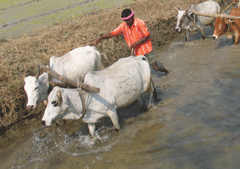 ORISSA, India, April 2009—In recent years there have been many reports about desperately indebted farmers in India. Throughout the world, farmers have become increasingly dependent on artificial fertilizers and pesticides to boost production. But the costs are high – and many poor farmers end up buried in debt.
ORISSA, India, April 2009—In recent years there have been many reports about desperately indebted farmers in India. Throughout the world, farmers have become increasingly dependent on artificial fertilizers and pesticides to boost production. But the costs are high – and many poor farmers end up buried in debt.
